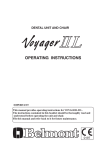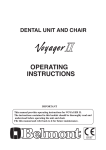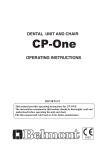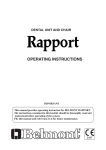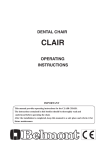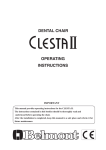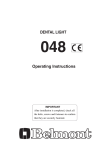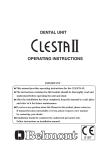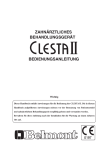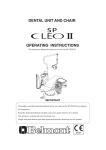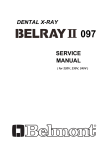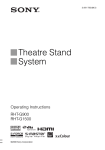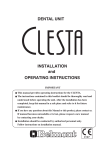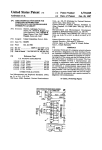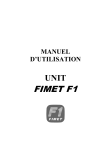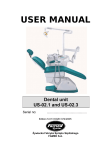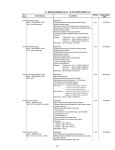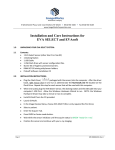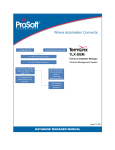Download OPERATING INSTRUCTIONS
Transcript
DENTAL UNIT AND CHAIR OPERATING INSTRUCTIONS IMPORTANT This manual provides operating instructions for SP-CLEO The instructions contained in this booklet should be thoroughly read and understood before operating the unit and chair. File this manual and refer back to it for future maintenance. 0197 TABLE OF CONTENTS 1. OVERALL VIEW AND MAJOR COMPORNENTS........................... 1 2. DIMENSIONS AND SPECIFICATIONS 2-1. Chair Section.................................................................................. 2 2-2. Cuspidor Unit Section.................................................................... 2 2-3. Doctor Unit Section....................................................................... 3 3. OPERATING AND ADJUSTMENT INSTRUCTIONS 3-1. Master Switch Section................................................................... 4 3-2. Cuspidor Unit Section.................................................................... 4 3-3. Doctor Unit Section....................................................................... 6 3-4. Utility Section................................................................................ 9 3-5. Foot Control Section...................................................................... 9 3-6. Chair Section.................................................................................. 9 4. DAILY MAINTENANCE...................................................................... 13 5. ELECTROMAGNETIC COMPATIBILITY.......................................... 16 6. LIST OF COMPATIBLE HANDPIECES ............................................. 19 Intended Use of the Product This product is an active therapeutic device intended for the exclusive use for diagnoses, treatments and relative procedures of dentistry. The product must be operated or handled by the qualified dentists or by dental staffs under the supervision of the dentist. Such dentists or dental staffs should instruct and/or assist the patients to approach to and leave from the product. Patients should not be allowed to operate or handle the product unless he/she is so instructed. The product is supplied together with the handpieces like electric micromotor, air turbine and/or motor, scaler and so on. Environmental Requirements Ambient Temperature Operating +5 ℃- +40 Humidity 10 % - 80% Atmospherical Pressure 600 hPa - 1060 hPa ℃ ℃- +50 Storage -10 ℃ Compatibility of Handpieces Use the compatible handpieces as shown on the attached list for this unit. (List of compatible handpieces). Important Notes In case of the troubles, please contat Takara Belmont offices or your dealers. Do not disassemble or attempt to repair. Disassembly, repair or modifications shoud only be done by a qualified repair technician. Attempts at disassembly, repair or modifications may lead to abnormal operation and accidents. In case of disposal of equipment When disposing the chair, appropriately dispose complying with all current applicable regulations and local codes. In EU area, EU directive 2002/96/EC on waste electrical and electronic equipment (WEEE) is applied on this product. In this directive, environment conscious recycling/abandonment is obligated. SYMBOLS Chair last position Chair auto return Chair preset1 Chair preset2 Chair auto control To raise the chair To Recline the backrest To lower the chair To raise the backrest Chair manual control Chair manual control Film viewer on/off Fiber optic handpiece light on//off Scaler power control Micro motor rotation speed control Micro motor Forward/Reverse select Handpiece coolant spray on/off Syringe Store Bowl flush Cupfiller Service outlet water flow control Service outlet (water) Service outlet (air) Air Type B Applied Parts Manufacturer Date of manufacture Water heater Non-ionizing radiation Caution It means “caution, warnings, or possibility to danger”. 㹌 㻨㻦 㻵㻨㻳 Water Authorized representative in the European community Separate collection for electrical and electronic equipment 㸶 1. OVERALL VIEW AND MAJOR COMPORNENTS CHAIR SECTION 1. Chair 2. Headrest 3. Backrest 4. Seat 5. Legrest 6. Footrest 7. Armrests 8. Backrest Rear Cover 9. Base Cover 10. Power Supply Panel 11. Doctor Table Arm 12. Chair Preset Panel 13. Stick Switch (Manual Mode) CUSPIDOR UNIT SECTION 14. Cuspidor Unit 15. Cupfiller Nozzle 16. Bowl Flush Nozzle 17. Cuspidor Bowl 18. Assistant Side Control Panel 19. Saliva Ejector 20. 3-way Syringe 21. High Volume Evacuator 22. Assistant Holder -1- DOCTOR UNIT SECTION 23. Doctor Table 24. Doctor Table Main Control Panel 25. Dental Viewer 26. Doctor Tray 27. Waste Receptacle 28. Handpiece Holder 29. Handpieces (Micromotor, Air Turbine/Motor, Scaler and etc.) Manufacturers recommend to use the handpieces with CE markings FOOT CONTROL SECTION 30. Foot Control LIGHT POST SECTION 31. Light Post 32. Light Pole 2. DIMENSIONS AND SPECIFICATIONS 2-1. CHAIR SECTION 605 570 13 487 5 10 10 82 215 70 495 530 480 460 185 487 ~ 787 452 1137 ~ 1437 1690 680 Seat Initial Height ..........................................................487 mm Seat Elevation Stroke..........................................................300 mm Headrest Slide Stroke..........................................................170 mm Legrest Slide Stroke ..........................................................230 mm Power Consumption ..........................................................230V, 50Hz 3.7A Weight..................................................................................148 kg Maximum Load....................................................................135 kg Service Life..........................................................................10 years 2-2. CUSPIDOR UNIT SECTION -2- After Ser. No.DCQ080177 2-3. DOCTOR UNIT SECTION BASE MOUNT TYPE CART TYPE -3- 3. OPERATING AND ADJUSTMENT INSTRUCTIONS 3-1. Master Switch Section Fig.3-1 Master Switch and Power Indicator (1) Master Switch (Fig.3-1) Master switch is located at right side rear under the doctor table. Master switch turns the air, water and electric power ON/OFF at the utility section. When master switch is off, air and water are shut off at hard pipings in the utility section. It is always recommended to turn off master switch when closing the office. (2) Power Indicator (Fig.3-1) Power indicator is located at centre of doctor table main control panel. When the master switch is ON position, a green L.E.D. illuminates. Note ; Before operation, turn on the main switch for chair. Ref. 3-6 (1-A) Main Switch for Chair. 3-2. Cuspidor Unit Section (1) Cuspidor Section Control Panel (Fig.3-2) Cuspidor section control panel is located inside of cuspidor unit body. (1-A) Water Heater Switch (Fig.3-2) Water heater switch allows warm water for cupfiller. Fig.3-2 Cuspidor Section Control Panel (1-B) Cupfiller Flow Control Valve (Fig.3-2) Cupfiller flow control valve adjusts cupfiller to suitable flow volume. (1-C) Bowl Flush Flow Control Valve (Fig.3-2) Bowl flush flow control valve adjusts bowl flush flow to optimum rinse action. (l-D) Assistant side syringe flow control valves (Fig.3-2) Assistant's syringe flow control valves adjust air and water to the assistant's syringe. Yellow capped knob is air flow control valve, blue capped knob is water flow control valve. Note ;Turning flow control knob to counter-clockwise, increases flow volume and turning to clockwise, decreases . -4- (2) Assistant Side Control Panel (Fig.3-3) Assistant side control panel is located on the front side of cuspidor unit. (2-E) Cupfiller Switch Momentarily press the cupfiller switch and cup will be filled with water. At the same time bowl flush water will flush out about 12 seconds and stop automatically. Water filling time is set for 5 seconds at factory. Note ; Cupfiller water flow volume can be adjusted by cupfiller flow control valve. Ref. 3-2. Cuspidor Section (1-B). (2-F) Bowl Flush Switch Momentarily press the bowl flush switch and bowl flush water will flush continuously until the bowl flush switch is pressed again. Note ; Bowl flush water flow volume can be adjusted by bowl flush flow control valve. Ref. 3-2. Cuspidor Unit Section (1-C). Fig.3-3 Assistant Side Control Panel (2-G) Water Outlet Water outlet provides quick-connect water. (2-H) Control Knob for Water Outlet Water flow adjustment provides water flow towater outlet. (2- I) Assistant side Chair Auto-Positioning Switches Ref. 3-6. Chair Section. (3) Assistant Side Instrument Holder Pick up the instrument (Saliva Ejector or High Volume Evacuator) from assistant holder it starts working automatically. Return the H.V.E. or S.E. handpiece to assistant holder, it stops after about 8 seconds working. (Central vacuum type only) (4) 3-way Syringe By depressing either or both buttons, syringe offers air, water and spray. Syringe tip can be rotated freely. Syringe air, water and spray can be adjusted by syringe flow control valve. Ref. 3-2. Cuspidor Section (1-D). (5) Cupfiller Water Temperature Adjustment (Fig.3-4) Cupfiller water temperature can be adjusted by water heater temperature adjustment screw. Water heater is located in cuspidor body and its adjustment screw is located on top. Turn to clockwise, increase cupfiller water temperature and turn to counter-clockwise, decrease water temperature. Note ; Confirm water temperature at any time after adjustment water heater. -5- Fig.3-4 Cupfiller Water Heater Temperature Adjustment 3-3. Doctor Unit Section (1) Doctor Table Main Control Panel (Fig.3-5) Fig.3-5 Doctor Table Main Control Panel (l-A) Dental Viewer Intraoral film can be mounted by a magnetic bar. (1-B) Dental Viewer Switch Momentarily pressing turns ON/Off the viewer. (1-C) Light Pack Switch (Option) Momentarily press light pack switch, fiber optic light power will be turned on untill light pack switch is pressed again. (1-D) Bowl Flush Switch Ref. 3-2. Cuspidor Unit Section (2-E). (1-E) Cupfiller Switch Ref. 3-2. Cuspidor Unit Section (2-F). (1-F) Doctor Side Chair Auto-positioning Switches Ref. 3-6. Chair Section. (1-G) Doctor Side Chair Manual Control Switches Ref. 3-6. Chair Section. (2) Control Knobs (Fig.3-6) Handpiece coolant water and air adjustment knobs, syringe flow adjustment knobs are located right hand side under the doctor table. Fig.3-6 Doctor Unit Control Knobs (2-H) Handpiece Coolant Water Adjustment Knobs For individual handpiece coolant water adjustment, handpiece coolant water adjustment knobs are lined up from front side HPl, HP2, HP3, .. The handpiece holder numbers are from facing left hand side HPl, HP2, HP3, .. (2- I) Handpiece Coolant Air Adjustment Knob Handpiece coolant air adjustment knob controls the flow of coolant air to all handpieces. (2-J) Doctor Side Syringe Flow Adjustment Knobs Doctor side syringe flow adjustment knobs adjust air and water to doctor side syringe. Yellow capped knob is air control knob, blue capped knob is water control knob. (2-K) Master Switch Ref. 3-1. Master Switch Section. Note ; Turning flow control knob to counter-clockwise, increases flow volume and turning to clockwise, decreases. -6- (3) Handpiece Drive Air and Coolant Air Adjustment Screws (Fig.3-7, Fig.3-8) Loosen 4-screws from the table bottom and open the table top. Auto select valve and handpiece pressure gauge are located in the table. Caution ; Please remove the table top carefully, because the table top is connected with wires behind the table top. (3-L) Handpiece Drive Air Adjustment Screw (Fig.3-8) Adjustment of drive air to each handpiece can be made by the screw on the auto select valve. It is important to set the drive air pressure in accordance to the handpiece manufacture's recommendation. Setting The Optimum Condition Turn the appropriate dive air screw fully clockwise, depress drive air pedal of foot control to fully open (maximum foot pressure) and turn the adjustment screw slowly in counter-clockwise direction. Stop turning the screw immediately when handpiece pressure gauge shows the desired drive air pressure. (3-M) Handpiece Coolant Air Adjustment Screws (Fig.3-8) Handpiece coolant air adjustment screws are provided for individual adjustment of handpiece coolant air. Fig.3-8 Auto Select Valve Fig.3-7 Doctor Table Inside (4) Control Knobs and Switches for Optional Euipment (Fig.3-9) SP-CLEO can be available fiber optic, electric scaler and electric motor as factory option. They can be controlled by the doctor unit section and foot control. (4-A) Electric Motor Power Control Knob (Option) Electric motor rotation speed can be controlled by electric motor power control knob. Turning electric motor power control knob to clockwise, increases rotation speed and turning tocounter-clockwise, decreases rotation speed. Fig.3-9 Control Knobs and Switchs for Optinal Equipment (4-B) Scaler Power Control Knob (Option) Scaler power can be controlled by scaler power control kob. Turning scaler power control knob to clockwise, increases scaler power and turning to counter-clockwise decreases scaler power. (4-C) Electric Motor Forward/Reverse Rotation Switch (Option) To turn electric motor forward/reverse rotation switch to facing right side, electric motor rotates forward and to turn to facing left side, electric motor rotates reverse. CAUTION Handpiece : Refer to handpiece manufacturers operating instructions. -7- (5) Handpiece Holder Angle (Fig.3-10) Handpiece holder angle can be adjusted by loosing M4 set screw at facing left hand side under the handpiece holder arm. After adjustment retighten M4 set screw. Handpiece holder angle can not be adjusted individually. Fig.3-10 Handpiece Holder Angle Adjustment Set Screw (6) Lock Knob for Doctor Table Height Adjustment (Fig.3-11) While supporting the doctor table by a hand, loosen lock knob to counter-clockwise and doctor table will go up and down freely. Adjust the height of doctor table and then tighten lock knob firmly. Base Mount Type Cart Type Fig.3-11 Lock Knob (7) Level Adjustment Screws for Doctor Table (Fig.3-12) Level of the doctor table can be adjusted by screwing/unscrewing four set screws located in the doctor table. Remove the table top and adjust the level by screwing/unscrewing the four set screws (level adjustment screws). Retighten the four set screws firmly. Fig.3-12 Level Adjustment Screws (8) Friction Adjustment set screw of table rotation (Fig.3-13) Friction of table rotation can be adjusted by the set screw located in table rotation flange under the table. (9) Friction Adjustment Nut of Horizontal Arm (Fig.3-14) Friction of horizontal arm can be adjusted by turning the nut located at the end of the horizontal arm. Fig.3-13 Table Rotation Friction Adjustment Set Screw Fig.3-14 Friction adjustment of Horizontal Arm -8- 3-4. Utility Section (Fig.3-15) (1) Air Pressure Regulate the output air pressure of compressor to the utility section at 0.54 - 0.59 Mpa (5.5 - 6.0 kg/cm2 )and air flow volume is at least 55 Nl/min (88 Nl/min ; in case of air vacuum type) Adjust the air regulator in the utility section at 0.49 - 0.54 Mpa (5.0 - 5.5 kg/cm2 ) [already adjusted at factory, Max. 0.49 Mpa (5.0 kg/cm2 .)] (2) Water Pressure More than 0.1 Mpa (1.0 kg/cm2 ) water pressure at the regulator in the utility section is requested for operating this unit efficiently. Adjust the water regulator in the utility section at 0.1 - 0.19 Mpa (1.0 - 2.0 kg/ cm2 ). [Already adjusted at factory, Max. 0.19 Mpa (2.0 kg/cm2 .)] Note ; In case of water saliva ejector, high water pressure supplies efficient suction power. Fig.3-15 Utility Section 3-5. Foot Control Section (Fig.3-16) (1) Drive Air Pedal Handpiece speed can be controlled by drive air pedal. (2) Coolant Water ON/OFF Switch Coolant water ON/OFF switch allows for coolant water to be turned on or off without disturbing flow adjustment. (3) Chip Blower Button By treading chip blower button on, chip blower comes out from handpiece without bur turning. On Off CHIP BLOWER BUTTON COOLANT WATER On/Off SWITCH 3-6. Chair Section (1) Chair Power Supply Panel (Fig.3-17) Chair power supply panel is located on sitting right hand side chair base. DRIVE AIR PEDAL Fig.3-16 Foot Control (1-A) Main Switch for Chair Main switch for chair turns electric power ON/OFF. Neon lamp in the main switch illuminates in green when chair and unit electric power is ON. (1-B) Fuse Holder and Fuse An over current protection device rated for 6.3A (230 type). Fig.3-17 Chair Power Supply Panel -9- Fig.3-18 Doctor Table Main Control Panel (2) Chair Manual Control Switches (Fig.3-18, Fig.3-19) Chair manual control switches are located on the doctor table main control panel and the sitting right hand side base cover (Stick Switch). (2-A) Seat Height Adjustment To Raise ; press ( ) button on main control panel or move up stick switch. To Lower ; press ( ) button on main control panel or move down stick switch. (2-B) Backrest Angle Adjustment To Raise ; press ( ) button on main control panel or move right stick switch. To Recline; press ( ) button on main control panel or move left stick switch. Fig.3-19 Stick Swich (3) Chair Auto Positioning Switches (Fig.3-18, Fig.3-20) Chair auto positioning switches are located on the doctor table main control panel and the assistant side control panel. (3-A) Preset Operation This chair has two preset positions. (Preset 1 and Preset 2). Momentarily press (1) button on main control panel or assistant side control panel, chair will move to preset 1 position automatically. (Preset 2 is operated by (2) button.) (3-B) Auto-return Operation Momentarily press (0) button on main control panel or assistant side control panel, chair will return to the initial position (Seat is fully lowered and backrest is upright position with footrest retracted). Note ; Footrest section operation can be controlled by only auto positioning mode. Fig.3-20 Assistant side Control Panel (3-C) Last Position Memory Operation Momentarily press (LP) button at reclined backrest position (treatment position) and backrest will raise to mouth rinsing position. Press momentarily LP button again, backrest will recline to previous treatment position. Note ; Seat height can not be changed by (LP) button. -10- (4) Headrest (4-A) Standard Type Headrest (Fig.3-21) Height Adjustment Press down or pull up headrest to the position required. Angle Adjustment Push the headrest forward as required. Lift the headrest lever to rotate the headrest backward. (4-B) Twin Axis Type Headrest (Option)(Fig.3-22) Height Adjustment Press down or pull up headrest to the position required. Angle Adjustment Holding the headrest cushion, grip the headrest release button and headrest can be moved freely. Adjust the headrest to suitable position and release headrest release button. (5) Armrest Rotation (Fig.3-23) Sitting right hand side armrest can be rotated by pulling outward. Fig.3-21 Standard Type Head- Fig.3-22 Twin Axis Headrest (6) Auto Positioning Mode Cancell System Automatic movement in all auto positioning mode (Preset 1, Preset 2, Auto-return and Last position memory) can be instantly cancelled at any time by momentarily depressing any chair control switch. (7) Chair Safety Lock System The SP-CLEO equips chair safety device to prevent from accidental crash or damage. (7-A) Handpiece Chair Safety Lock System During runinig handpiece, chair safety lock system is working and the chair can not be operated by any switch. Fig.3-23 Armrest Rotation (7-B) Doctor Table First Arm Chair Safety Lock System (Fig.3-24) When doctor table first arm is turned to clockwise about 30 degree into backrest side, chair safety lock system is working and the chair can not be operated by any switch. (7-C) Doctor Table Lift Chair Safety Lock System When the doctor table is lifted up, chair safety lock system is working and the chair can not be operated by any switch. Fig.3-24 Doctor Table First Arm Chair Safety Lock System Note ; When chair safety lock system is working, LOCK OFF L.E.D. on the chair preset panel will be turned off. (Fig.3-25) -11- (8) Preset Position Adjustment (Fig.3-25) Fig.3-25 Chair Preset Panel 1. Set seat and backrest in the desired position by manual control switches. 2. Keep depressing (1) button on doctor table or assistant side control panel until buzzer sounds so that the position is memorized to PRESET 1, then the buzzer sound ceases. 3. PRESET 2 is memorized by pressing (2) button as following 1 to 2. (9) Mouth Rinsing Backrest Position Adjustment (Fig.3-25) The desired mouth rinsing backrest position can be programmed as last position memory operation. 1. Set backrest in the desired position by manual control switches. 2. Keep depressing (LP) button on doctor table or assistant side control panel until buzzer sounds so that the position is memorized to mouth rinsing position, then the buzzer sound ceases. -12- 4.CARE AND MAINTENANCE CAUTION Turn off the master switch at the initial position after daily operation or in long term interval. Turn off the main water valve after daily operation or in long term interval. 4-1. Care and maintenance for chair 4-1-1. Other than cleaning, no scheduled maintenance of chair is required. CAUTION Do not drench the chair for cleaning. Do not use polishing powder, solvents, strong disinfectant and hot water for cleaning. After cleaning, wipe with a dry soft cloth and keep dry. Upholstery can be cleaned with a neutral detergent. Paint parts, metal parts and plastic parts can be cleaned with DURR FD333 cleaner ( or equivalent). Do not drench the chair and unit. Wipe all surfaces dry after cleaning. 4-2. Care and maintenance for unit 4-2-1. Cleaning unit CAUTION Do not drench the unit for cleaning. Do not use polishing powder, solvents, strong disinfectant and hot water for cleaning After cleaning, wipe with a dry soft cloth and keep dry. All surfaces can be cleaned with DURR FD333 cleaner ( or equivalent). Spray the cleaner (DURR FD333) on cloth and wipe the surfaces with the cloth. Do not drench the chair and unit. Wipe all surfaces dry after cleaning. 4-1. Basket Strainer (Fig.4-1) Take out the basket strainer in centre of cuspidor bowl and clean it. 4-2. Solid Collector (Fig.4-1) Open the side panel of the cuspidor body and take out solid collector container and filter and clean them. Fig.4-1 Cuspidor Bowl -13- 4-3. Handpieces 1. Vacuum Handpiece and Saliva Ejector (Fig.4-2) A. Pull and remove the top parts of each handpiece and clean strainer. B. After daily operation, run two cup of clean water through the handpieces to clean inside. Sterilization Vacuum Tip/Saliva Ejector Tip/Vacuum Cap/Vacuum Handpiece Body/Saliva Ejector Handpiece Body can be sterilized with autoclave. Vacuum handpiece body and saliva ejector body must be assembled before autoclaving. A. Wash off dirt of the handpiece with natural detergent. B. Rinse the handpiecwe with tap water. C. Insert the handpiece in a sterilization pouch and seal it. D. Autoclave for 20 min. at 121℃. Vacuum Tip Saliva Ejector Tip Vacuum Cap Vacuum Handpiece Body Slide Knob Vacuum Hose Saliva Ejector Handpiece Body Slide Knob Saliva Ejector Hose Fig.4-2 H.V.E. and S.E. Hand -piece Note: The slide knob can be autoclaved 100 times and is an expendable supply. CAUTION • Skip dry cycle. Note : After cleaning the handpieces, apply a white vaseline lightly on the rubber parts (O-Ring) and screws parts for long life. Keep the handpieces in a clean place. 2. Micro Motor / Air Motor / Turbine / Scaler Sterilize the handpiece according to manufacturer’s operating manual. 3. Belmont 77 Syringe (Fig.4-3 ) A. Remove the nozzle from syringe and clean it Sterilization A. Wash off dirt of the handpiece with natural detergent. B. Rinse the handpiecwe with tap water. C. Insert the handpiece in a sterilization pouch and seal it. D. Autoclave for 20 min. at 121℃. CAUTION • Skip dry cycle. Keep the syringe in a clean place. 4. Tubing and Hose It is recommended that Durr FD333 be used to clean the exterior parts of tubing and hose -14- Fig.4-3 H.V.E. and S.E. Handpiece 4-4. Drain Valve for Air Filter in Utility Section (Fig.4-4) Open the drain valve once a week to drain off the water from the air filter in utility section. 4-5. Vinyl leather of chair Wipe the vinyl leather with soft cloth using upholstery cleaner. 4-6. Master Switch After the daily operation and maintenance, turn off the master switch under the doctor table. Ref. 3-1. Master Switch Section -15- Fig.4-4 Utility Section 5.ELECTROMAGNETIC COMPATIBILITY(EMC) Medical electrical equipment needs special precautions regarding EMC and needs to be installed and put into service according to the EMC information provided in this manual. Portable and mobile RF communications equipment can affect medical electrical equipment. The equipment or system should not be used adjacent to or stacked with other equipment. If adjacent or stacked use is necessary, the equipment or system should be observed to verify normal operation in the configuration in which it will be used. Guidance and manufacture’s declaration - electromagnetic emissions The SP-CLEO is intended for use in the electromagnetic environment specified below. The customer or the user of the SP-CLEO should assure that it is used in such an environment. Emissions test Compliance Electromagnetic environment - guidance RF emissions The SP-CLEO uses RF energy only for its internal function. CISPR 11 Therefore, its RF emissions are very low and are not likely Group 1 to cause any interference in nearby electronic equipment. RF emissions The SP-CLEO is suitable for use in all establishments, Class B CISPR 11 including domestic establishments and those directly Harmonic emissions connected to the public low-voltage power supply network Class A IEC 61000-3-2 that supplies buildings used for domestic purposes. Voltage fluctuations/ Flicker emissions Complies IEC 61000-3-3 Guidance and manufacture’s declaration – electromagnetic immunity The SP-CLEO is intended for use in the electromagnetic environment specified below. The customer or the user of the SP-CLEO should assure that it is used in such an environment. IEC 60601 Electromagnetic environment Immunity test Compliance level test level guidance Electrostatic ±6 kV contact ±6 kV contact Floors should be wood, concrete or discharge (ESD) ±8 kV air ±8 kV air ceramic file. If floors are covered IEC 61000-4-2 with synthetic material, the relative humidity should be at least 30%. Electrical fast ±2 kV for power ±2 kV for power Mains power quality should be that transient/burst supply lines supply lines of a typical commercial or hospital IEC 61000-4-4 ±1 kV for input/output ±1 kV for input/output environment. lines lines Surge ±1 kV differential mode ±1 kV differential mode Mains power quality should be that IEC 61000-4-5 ±2 kV common mode ±2 kV common mode of a typical commercial or hospital environment. Voltage dips, short <5% UT <5% UT Mains power quality should be that interruptions and (>95% dip in UT) (>95% dip in UT) of a typical commercial or hospital voltage variations for 0.5 cycle for 0.5 cycle environment. If the user of the SPon power supply 40% UT 40% UT CLEO requires continued operation input lines (60% dip in UT) (60% dip in UT) during power mains interruptions, it IEC 61000-4-11 for 5 cycle for 5 cycle is recommended that the SP-CLEO 70% UT 70% UT be powered from an uninterruptible (30% dip in UT) (30% dip in UT) power supply or a battery. for 25cycle for 25cycle <5% UT <5% UT (>95% dip in UT) (>95% dip in UT) for 5 s for 5 s Power frequency 3 A/m 3 A/m Power frequency magnetic fields (50/60 Hz) should be at levels characteristic magnetic field of a typical location in a typical IEC 61000-4-8 commercial or hospital environment. NOTE UT is the a.c. mains voltage prior to applications of the test level. -16- Guidance and manufacture’s declaration - electromagnetic immunity The SP-CLEO is intended for use in the electromagnetic environment specified below. The customer or the user of the SP-CLEO should assure that it is used in such an environment. Compliance Immunity test IEC 60601 test level Electromagnetic environment - guidance level Portable and mobile RF communications equipment should be used no closer to any part of the SPCLEO, including cables, than the recommended separation distance calculated from the equation applications to the Frequency of the transmitter. Conducted RF IEC 61000-4-6 3 Vrms 150 kHz to 80 MHz outside ISM bandsa 3 Vrms Radiated RF IEC 61000-4-3 3V/m 80 MHz to 2.5 GHz 3 V/m Recommended separation distance d = 1.2√P d = 1.2√P 80 MHz to 800 MHz d = 2.3√P 800 MHz to 2.5 GHz Where P is the maximum output power rating of the transmitter in watts (W) according to the transmitter manufacturer and d is the recommended separation distance in metres (m). Field strengths from fixed RF transmitters, as determined by an electromagnetic site survey,a should be less than the compliance level in each frequency range.b Interference may occur in the vicinity of equipment marked with the following symbol: NOTE 1 At 80 MHz and 800MHz, the higher frequency range applies. NOTE 2 These guidelines may not apply in all situations. Electromagnetic propagation is affected by adsorption and reflection from structures, objects and people. a Field strengths from fixed transmitters, such as base stations for radio (cellular/cordless) telephones and land mobile radios, amateur radio, AM and FM radio broadcast and TV broadcast cannot be predicted theoretically with accuracy. To assess the electromagnetic environment due to fixed RF transmitters, an electromagnetic site survey should be considered. If the measured field strength in the location in which the SP-CLEO is used exceeds the applicable RF compliance level above, the SP-CLEO should be observed to verify normal operation. If abnormal performance is observed, additional measures may be necessary, such as reorienting or relocating the SP-CLEO. b Over the frequency range 150 kHz to 80 MHz, field strengths should be less than 3V/m. Essential performance (purpose of IMMUNITY testing) Unless operated by the switches for chair control, the chair section of the SP-CLEO does not make any movements, except for sounding a buzzer and switching on/off the indicator. -17- Recommended separation distances between Portable and mobile RF communications equipment and the SP-CLEO The SP-CLEO is intended for use in an electromagnetic environment in which radiated RF disturbances are controlled. The customer or the user of the SP-CLEO can help prevent electromagnetic interference by maintaining a minimum distance between portable and mobile RF communications equipment (transmitters) and the SP-CLEO as recommended below, according to the maximum output power of the communications equipment. Separation distance according to frequency of transmitter Rated maximum output power m of transmitter 150 kHz to 80 MHz 80 MHz to 800 MHz 800 MHz to 2.5 GHz W d = 1.2√P d = 1.2√P d = 2.3√P 0.01 0.12 0.12 0.23 0.1 0.38 0.38 0.73 1 1.2 1.2 2.3 10 3.8 3.8 7.3 100 12 12 23 For transmitters rated at a maximum output power not listed above, the recommended separation distance d in metres (m) can be estimated using the equation applicable to the frequency of the transmitter, where P is the maximum output power rating of the transmitter in watts (W) according to the transmitter manufacturer. NOTE 1 At 80 MHz and 800MHz, the separation distance for the higher frequency range applies. NOTE 2 These guidelines may not apply in all situations. Electromagnetic propagation is affected by adsorption and reflection from structures, objects and people. -18- 6. LIST OF COMPATIBLE HANDPIECES DESCRIPTION Syringe DCI (3-WAY) Turbine BIEN AIR BORA S36L / UNIFIX with LIGHT NSK Ti-Max X Air motor BIEN AIR Aquilon 830 / UNIFIX with LIGHT /PM1132 NSK EX-203 / EX-6 Micromotor BIEN AIR MC3LK / PLMP021PCB. / PM1132 BIEN AIR MC3LK / PL970 PCB. / PM1132 Scaler SATELEC SP4055 w/Light -19- NOTE Takara Belmont (UK) Ltd. Belmont House One St.Andrews Way,Bow, London E3 3PA U.K. Tel: (44)20 7515 0333 Fax:(44)20 7987 3596 TAKARA BELMONT CORPORATION 2-1-1, Higashishinsaibashi,Chuo-ku,Osaka,542-0083,Japan TEL : 81-6-6213-5945 FAX : 81-6-6212-3680 BOOK NO. AFFY23E0 Printed in Japan 1110
























